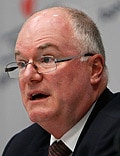HOUSTON, Texas — For patients with acute stroke, there does not appear to be any clear benefit or harm from lying flat vs sitting up in the first 24 hours, results of a new trial show.
The Head Position in Acute Stroke Trial (HeadPoST) was presented here at the International Stroke Conference (ISC) 2017.
Lead investigator, Craig S. Anderson, MD, George Institute of Global Health, Sydney, Australia, explained that there is a debate over whether stroke patients should be positioned with their heads upright or lying flat.

Dr Craig S. Anderson
"Raising the head may be better to reduce acute swelling, but there is some thinking that lying flat may promote blood flow to the brain. This strategy is becoming popular. But there is some concern that lying flat may increase the risk of saliva aspiration which can lead to pneumonia," he said.
Results of HeadPoST show that "in acute stroke patients, positioning either lying flat or sitting up in the first 24 hours of hospitalization provides no difference in disability or safety outcomes, with no clear benefits or harms in any subgroups according to time from onset of symptoms, initial stroke severity, age, region, and type of stroke," he said. "So we can't make any clear recommendations about head positioning in acute stroke."
He noted, however, that lying flat can be uncomfortable.
Commenting on the study for Medscape Medical News, Bruce Ovbiagele, MD, professor and chief of neurology at Medical University of South Carolina, Charleston, and program chair of the ISC 2017, suggested that the neutral results could have occurred because most patients enrolled had mild strokes.

Dr Bruce Ovbiagele
"When we talk about blood flow being helpful when we put the head flat, we're thinking more about the large strokes for whom alternative channels would be most beneficial," he said. "However, these patients with large strokes may also be less able to protect their airway and therefore are at higher risk of aspiration pneumonia. So this is the population we need to focus on.
"For me, an important finding in this study was that there was more discomfort in the patients who were lying flat," Dr Ovbiagele added. "While this is not a hard outcome, if a patient is uncomfortable and there is no difference in the major outcomes, then this will guide my practice."
As an introduction to his presentation, Dr Anderson noted that current American Heart Association/American Stroke Association guidelines give mixed advice on head positioning in acute stroke.
On the one hand they state: "In non-hypoxic patients able to tolerate lying flat, a supine position is recommended." But they add that: "Patients at risk for airway obstruction or aspiration and those with suspected elevated intracranial pressure should have the head of the bed elevated 15° to 30°," and concluded that, "The ideal position of a stroke patient to optimize these parameters, however, is unknown, and the clinician must balance often competing interests, as well as patient tolerance."
For the HeadPoST study, 11,093 patients with acute stroke were randomly assigned to an upright position (≥30°) or lying flat. The position was applied early and continued for 24 hours.
Dr Anderson noted that the population enrolled was "typical of what we see in the stroke unit." Patients had relatively mild strokes — average National Institutes of Health Stroke Scale score was 4 (range, 2 - 9), and average time from symptom onset was 14 hours (range, 5 - 35 hours); 86% of patients had an ischemic stroke, 8% had a hemorrhagic stroke, and 6% had a transient ischemic attack or stroke mimic. Thrombolysis was given in 12% of cases.
Results showed no difference in the primary outcome of unadjusted shift in modified Rankin Scale (mRS) scores at 90 days: odds ratio, 1.01 (95% confidence interval, 0.92 - 1.10; P = .84). There was also no signal of benefit or harm in any subgroup.
All secondary endpoints were also neutral, including adjusted shift mRS score, binary (0 - 2 vs 3 - 6) mRS score, length of stay, and shift mRS score at 7 days.
There was also no indication of harm, with no difference in adverse events or pneumonia in the two groups.
"We know that blood flow to the brain is important, but whether we can improve on what nature has put there is debatable," Dr Anderson concluded. "This study suggests that we may not be able to."
New Trial Design
HeadPoST was novel in that it involved a new hospital crossover design in which hospitals were randomly assigned to enroll clusters of patients, all of whom would lie flat as the policy, then they would switch to the upright position in a new cluster of patients.
"Enrollment was very fast," Dr Anderson noted. "We randomized 11,000 patients from 114 hospitals in 9 countries in less than 18 months. This is unprecedented in this type of patient group."
"This is the largest nurse-driven stroke trial ever conducted, and the novel design enabled very fast enrollment. This will inform a lot of stroke trials going forward," Dr Ovbiagele added. "In terms of design this a big step forward."
The study was funded by the National Health and Medical Research Council (NHMRC) of Australia. Dr Anderson receives grant support from the NHMRC and reimbursement from Takeda China and Boehringer Ingelheim for speaker fees and travel expenses.
International Stroke Conference (ISC) 2017. Abstract LB1. Presented February 22, 2017.
For more Medscape Neurology news, join us on Facebook and Twitter
Medscape Medical News © 2017 WebMD, LLC
Send comments and news tips to news@medscape.net.
Cite this: Sitting Up or Lying Flat: Similar Outcomes in Acute Stroke - Medscape - Feb 22, 2017.












Comments